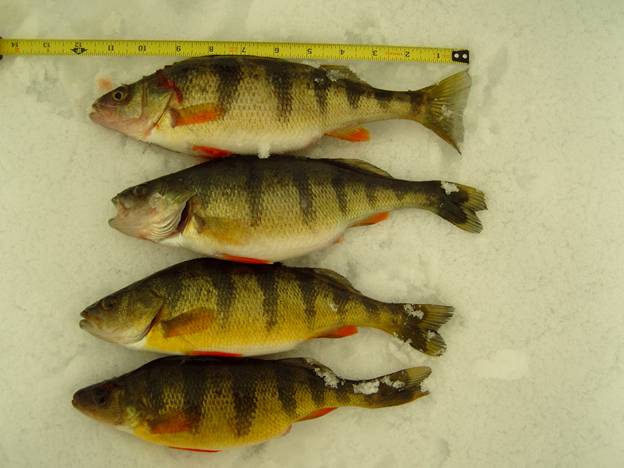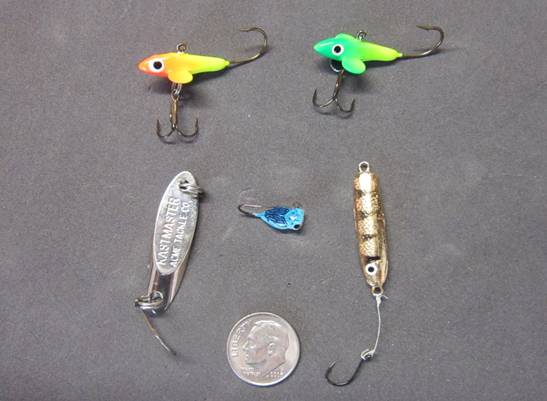Author’s note: The entry below is the first in a series of brief articles on ice fishing for various popular fish species. It is not a be all and end all tips and tactics manual, but more of an entry level guide that may be helpful to the novice ice angler. I am limiting the guide only to species that I have caught and am reasonably proficient at catching. For example, I have never caught a walleye or a bass through the ice, so I’m in no position to write about ice fishing for those species. I welcome submissions by writers/anglers detailing how to ice fish for species I am unable to cover.
Considered by some anglers to be a delicious target species and annoying and bait thieving trash fish by others, yellow perch are undeniably the ultimate beginner’s fish. They are active throughout the year, bite readily on a wide variety of baits and lures, and feed voraciously at midday. In waters where they are present, it is often difficult to avoid catching perch. Although they lack the sharp teeth of such species as pike and pickerel, care should still be taken when icing and unhooking yellow perch as their dorsal fins, pectoral fins, ventral fins, and gill plates are spiny and can inflict painful cuts and punctures.

Above: A wintertime catch of large yellow perch
Typical size
Most perch iced by anglers will be less than 10-inches in length and weigh less than a pound. However, occasionally a lucky ice angler fishing a large, deep lake or pond will locate a school of 10- to 12-inch perch that will yield decent-sized boneless fillets.
Tackle, lures, and bait
Tackle: An ultra-light jigging combo rigged with 4-6 pound test line is probably the most efficient tool for fishing perch as they congregate in schools. Where anglers are allowed by law to ice fish by deploying multiple lines simultaneously, tip-ups can also be an effective method by which to catch perch.
Lures: Any small, bright, and/or shiny jig or spoon that weighs less than ½-ounce will work for perch. Excellent choices include smaller sized jigs and spoons such as Swedish Pimples, and Hali jigs. Such lures are most effective when tipped with at least a little bait.
Baits: Perch are not picky and will bite on pretty much anything meaty. Good baits include small baitfish such as shiners, earthworms, mealworms, waxworms, and maggots.

Above: A selection of perch-capable jigs and lures
Fishing Methods
As mentioned earlier, it is harder to avoid catching yellow perch than it is to catch them. I have caught them in water as shallow as three feet and in water as deep as 40-feet, both near the bottom and just under the ice. That being said, I have noticed that larger perch during the winter months will be found within one foot of the bottom in 20 to 30 feet of water.
To fish for them, lower a baited jig to the bottom and then reel in a few inches of line. Move your hand just enough to give the jig a slight bouncing or shuddering movement interspersed with periodic pauses. Perch are active feeders during the winter, but they are typically more sluggish than in the summer and lack the ambition to chase a fast moving jig or lure. If a few minutes of jigging yields no bites, reel in a little more line and repeat the process. If no perch bite within 15 minutes, it may be prudent to move on to a new location.
Tip-up users should suspend bait 6 to 18 inches off the bottom and keep their lines relatively close together in order to accommodate the schooling nature of perch.
As table fare
The meat of yellow perch is undoubtedly exquisite. Properly cooked fillets are white, mild and flaky and are good lightly seasoned and grilled, deep-fried, or in soups and chowders. Unfortunately, the meat to bone ratio of a perch is very low and even larger specimens yield only bite-sized boneless fillets. Additionally, the meat of perch and other warm water fish is often heavily infested with parasitic flatworm larvae known as Clinostomum complanatum. While properly cooking the fillets will kill the worms and make the fish safe to eat, most anglers (myself included) are not willing to consume parasitic worms even when perfectly seasoned and cooked well-done. (14)




